Interview by Göksu Kunak in Berlin; Thursday, Oct. 29, 2015
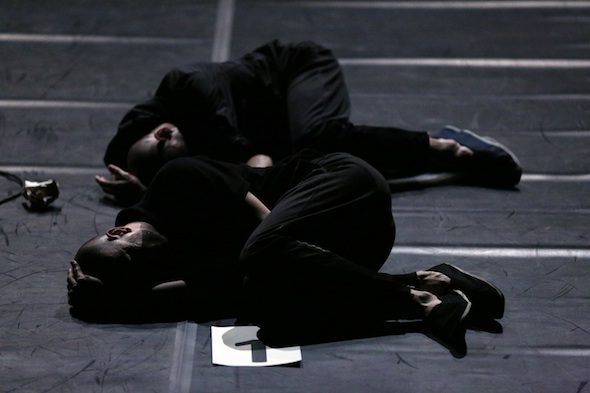 Darko Dragicevic and Martin Sonderkamp – “TASK 14” (2014); Photo by Maja Kljaić, courtesy of .CHB
Darko Dragicevic and Martin Sonderkamp – “TASK 14” (2014); Photo by Maja Kljaić, courtesy of .CHB
These days, the idea of installation even resounds in the field of performance. More than the traditional 2-hour stage production, performances have aimed to capture and remain with us. Audiences have become accustomed to durational pieces like ‘The Artist is Present’ by Marina Abramovic or Jan Fabre’s recent 24-hour piece ‘Mount Olympus’. The notion of performance installation has even spread to literature: writer Kenneth Goldsmith transcribed everyday performativity in his book Day by recording every word he experience for a week.
Visual artist and filmmaker Darko Dragicevic and dancer-choreographer Martin Sonderkamp will be eating, drinking, thinking, moving and basically inhabiting the space of Collegium Hungaricum Berlin (.CHB) from October 26th onward. Approximations is a 168 hours performance (installation or living situation), in which the artists will experiment with movement by expanding the notion of time and space. The performance will be open to the public between October 29th and November 1st.
Besides giving me some hints about the upcoming performance, the artist-couple talked about their understanding of time and collaboration.
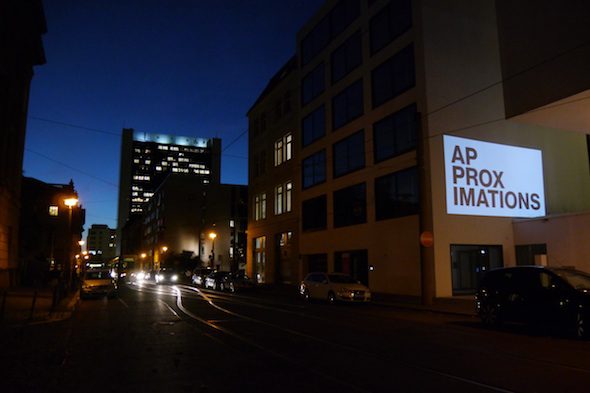 Martin Sonderkamp and Darko Dragicevic – ‘Approximations’ at Collegium Hungaricum Berlin CH.B; Photo by Martin Mallon, courtesy of .CHB
Martin Sonderkamp and Darko Dragicevic – ‘Approximations’ at Collegium Hungaricum Berlin CH.B; Photo by Martin Mallon, courtesy of .CHB
Göksu Kunak: You are coming from different backgrounds — dance and visual arts — and recently started collaborating. Despite the notion of interdisciplinarity, the languages might differ. How did you find a mutual way of talking?
Martin Sonderkamp: Rather than translating, we are looking at what kind of problems will arise when two disciplines come together. We are trying to understand the logic behind the actions of bodies that are trained differently. Contrary to our aims, interdisciplinarity has the tendency to translate the problems and to look for an answer. For example, we were sometimes observing how we place an object in the space and contemplated on what it means to us. In that manner, it was more a process of working next to each other, than starting to speak the same language. Letting things happen at the same time and not being trans/inter-disciplinary is more exciting for us. We let the gut feelings come out. Setting protocols or finding a framework comes much later. We like the presence of two art forms at the same time without feeling the urge to bind them together. I think one tends to use such terminology, because she/he is in the academic field. Then, everyone knows what it means.
Darko Dragicevic: One of the things we give importance to from the beginning is allowing ourselves to step into each other’s disciplines. Martin is a choreographer and dancer. I, by not being one, have a different approach towards the body. How we perceive our bodies or movement from our own perspectives mainly interest us.
GK: In ‘TASK 14’ you use text as an object — there is even a part where a text is read repetitively. Darko takes time to read the text about space and architecture. How do you think the meaning of the text transform the performance?
DD: ‘TASK 14’ was our very first collaboration performed in 2014. We used the poem ‘This Connection of Everyone with Lungs’ by Juliane Spahr. The text allowed us to expand the physical space as the space in the poem continuously grows. We used the concept of the poem and transferred it into our bodies.
MS: The question is: why did we use that text? It is about 9/11, the particles of debris that people started to breathe in. What both of us liked was that it talks about the body from the body — the space between fingers or, say, the exchange between the selves.
Of course, during the performance sometimes the text takes over and marks the body in a certain way. Our actions were following the text spatially as well. There is a movement in the text that is aligned with how we choreographed the space. And, most importantly, we used our own mediums to express.
DD: Personally, I don’t perceive the text as an object. For me the object has a certain shape. I’d rather think about it as an element. We were trying to avoid shaping forms, even when we work with projection or texture. In that sense, this text continuously changes in the piece in relation to our presence and acts. It transforms as it goes.
MS: Honestly, there was also this other layer as ‘we the lovers’. It is an important fact. There was no narration, or meaning, however I could feel Darko as a person as well, not just as a performer.
GK: Cause there is bodily memory that you two share?
MS: Exactly. That was quite beautiful. It was kind of double-edged. On the one hand, there was a sexual tension, in a good way. On the other hand, we were trying to expand our presence in the space. So, therefore, when I was approaching a certain object, I was taking the other body into consideration by asking: “How would that feel for him?”
My father had died a few months before the performance. Then, it wasn’t planned, but when I was working with the white fabric it created an intimate space as a reference to his dead body. So it was another way of telling a story without giving the details of my personal life. It was the resonation of a sad experience in my body and how it became material per se without a specific shape.
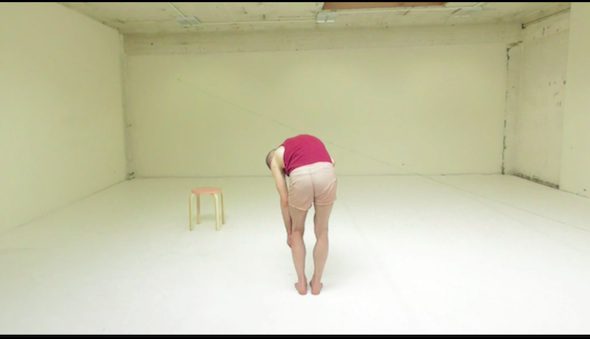 Martin Sonderkamp & Darko Dragicevic – “Approximations”; Photo courtesy of .CHB and the artists
Martin Sonderkamp & Darko Dragicevic – “Approximations”; Photo courtesy of .CHB and the artists
GK: How did the ideas develop in the workshops you gave in Cologne? Could you tell that those workshops shaped Approximations?
DD: First, we started with the workshop in Tanz Quartier in Vienna in October 2014. The second one was in Hochschule für Musik und Tanz in Cologne in March and April 2015.
MS: In the workshop, we started to focus more on personal diaries. From there, the lectures transformed; I shared practice and Darko shared his ideas about visual arts. For example, we talked about how to make the space visible between an artwork itself and the person observing. We worked on the same ideas that have been coming out with different materials — I don’t want to say disciplines…
GK: Could you describe the ideas behind the long durational performance Approximations that will take place in Collegium Hungaricum Berlin?
DD: I think: no. Approximations is more a product of residencies and collaborations with photographers, architects and dramaturges that we had this year. After TASK 14, we have been working all the time. Not just physically, but also by writing and sharing a lot outside of private spheres. There is already so much material for the 7 day performance next week; an exhibition and a mapping process will be shared as well.
MS: I think, indirectly, workshops influenced us. I saw Darko’s discipline from a new point of view, for instance. It was an exposure to each other’s works. In that sense, we got more intimate.
While working for the performance, we gave ourselves different tasks. One week our architect friend Brenda started mapping my flat. We looked how we move in that particular space and what happens where etc. We are artists, but in real life we’re a couple. How can we keep working together, without disturbing the private? We didn’t see being a couple as a superficial thing and pretend that now we switch and start making art.
GK: Yeah, this whole being professional thing..
MS: (Laughs) So, the next task was to only allow ourselves to communicate through images when we were in different cities. For me, I’ve never thought about how to compose images to communicate or to express my feelings. Of course, there were misunderstandings, however we learned to capture moments and feelings through photography. The cool thing with images is you can go back and look at what you said.
DD: There is this old-Latin phrase: “Verba volant, scripta manent” meaning “Words fly, what’s done remains”. I believe in that, in general. Our communication remains as an archive.
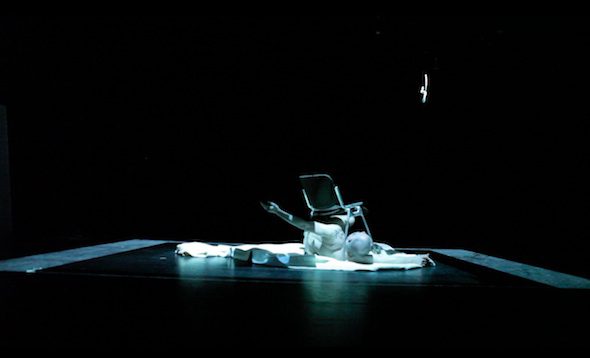 Martin Sonderkamp & Darko Dragicevic – “Approximations”; Photo by Milica Lopicic, courtesy of .CHB
Martin Sonderkamp & Darko Dragicevic – “Approximations”; Photo by Milica Lopicic, courtesy of .CHB
GK: Why is Approximations 168 hours/7 days? What does this time stand for?
MS: In a theater, everything is set in terms of time. You rehearse and then perform. We could have just done that. However, we didn’t want to exclude the way the space is felt. Therefore, we decided to see this performance more as an installation. That’s why we work with a durational piece, where we, as artists, have the possibility not only to mark the space choreographically, but also live it. By inhabiting the space, we go beyond just being on a stage.
DD: We wanted to play with the format what is considered as performance. We continuously break the structure of our work. Also, how will the audience be positioned in such a setting? It is also about physically spending time in the space of performance; we’re going to be sleeping, eating and working in that room.
GK: Time is such an important element in performance and dance. Now, you aim to stretch that given time. How do you think your perception of time will change after a performance of 168 hours?
DD: Today, I read this beautiful text asking how it would be if there were clocks that are only showing the time we spend by playing with our kids, having sex, reading books. There wouldn’t be numbers, but chunks of time.
Five years ago, I took part in a project in Berlin called ‘Taste of Life’. For a month, I lived in a van without ever leaving it. Everyday we were changing our location; people could follow the map and visit the moving exhibition. What it did to my perception of space and time was absolutely insane. Remembering that experience, I wonder how it will be when the first time the audience steps in. We will be really isolated for couple of days and one night other bodies will enter.
MS: We’ve been working on a few practices that we looked at how a certain way of using your senses influence both the timing inside you and the visible time for somebody else. It’s quite amazing when you actually slow down in outside of yourself and realize that time flows differently. It is much more simultaneous and less linear in that sense. There are movements in the body — forward-backward etc.— that makes you suddenly linger in a certain point without actually moving from there. If you, say, move quickly around a standing object, how those two different timings can blur in terms of perception? Funky, but I enjoy that. This is an experiment. I don’t know how it would be to watch it as an audience.
GK: What kind of objects will you use?
DD: We’d like to use the word material, instead. We work a lot with shifting spaces. What we do with space is what we do with our bodies. Besides that, the ones we choose are specific materials with certain textures that will cover the space. Painting will be a part of it. This will be a piece that grows and transforms. So when the audience comes on different nights, they’d be able to see how a simple visual language changes through movement from day to day.
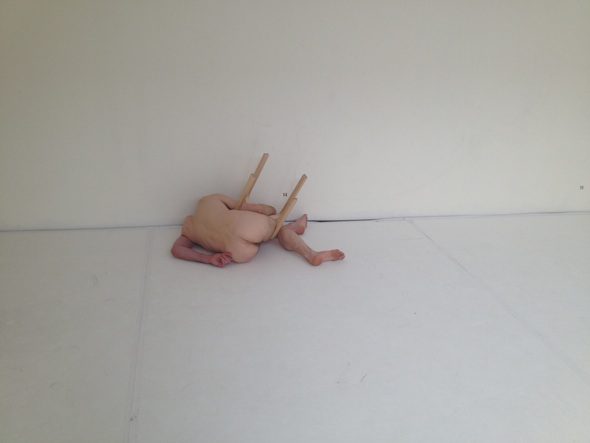 Martin Sonderkamp in Cologne; Photo by Darko Dragicevic
Martin Sonderkamp in Cologne; Photo by Darko Dragicevic
GK: There is a stunning image of a naked body in front of a white wall with a wood element attached to it in the mail that was sent to me about Approximations. Do you see/use nakedness as a costume or does the costume, clothing transform your performance?
MS: The wood element is an Ikea chair. How do the organic body and the non-living — the breathing body and the Ikea chair — exist in conjunction with one another? That was from our residency in Cologne after other ones, which we were dealing with architecture of affect and how to create certain emotions through visuals.
DD: We were also working a lot with memory.
MS: There was another residency in Ljubljana that we were co-authoring texts. With a dramaturg we collected texts, cut them out and also put them in the space for the body to interact with them. After observing how we create texts and how our bodies act as a sign, in the last residency we were focusing on timing very particularly. There were texts about being on the edge of something. After a while, a game started: the response to the texts had to be with images. Through our bodies and possible materials we were again re-responding to the images. We mapped, sketched the space and marked the relation between the body and the visuals. So, the last residency was like making a ground plan. Almost like a matrix of what we are doing now.
GK: Coming back to the image: Do you use nakedness as a costume?
MS: On the photo, it is not seen that the chair is almost the color of my skin. I don’t think we try to avoid the naked as the costume. Nakedness is something quite powerful because of stereotypical perceptions of the body. I think not seeing the head blurs the image of body as we know — it becomes an amorphous thing. Therefore, it can work with another fabric as well.
GK: Are you afraid of failure after being in the space for 7 days?
DD: I would really like failure to happen. That is something we were contemplating a lot this year. Failure is something that should be embraced. In that sense, we create this open structure in Approximations so that, hopefully, failure will be happening.
MS: The title is already quite a failure. It says that you will never reach. Failure for me is really positive. Challenge makes me more alert. In the moment of performance, I can still reflect on my choices and navigate. Therefore, Approximations won’t be a work that is set in stone. It is an experiment in a laboratory.
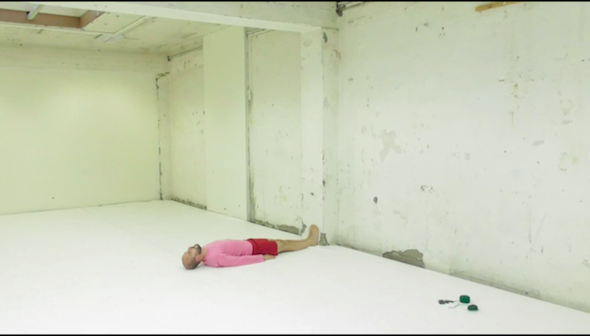 Martin Sonderkamp & Darko Dragicevic – “Approximations”; Photo courtesy of .CHB and the artists
Martin Sonderkamp & Darko Dragicevic – “Approximations”; Photo courtesy of .CHB and the artists
___________________________________________________________________________________
Additional Information
COLLEGIUM HUNGARICUM
“Approximations” – MARTIN SONDERKAMP & DARKO DRAGICEVIC
Exhibition: Oct. 29 – Nov. 01, 2015
Dorotheenstraße 12 (click here for map)
___________________________________________________________________________________




















